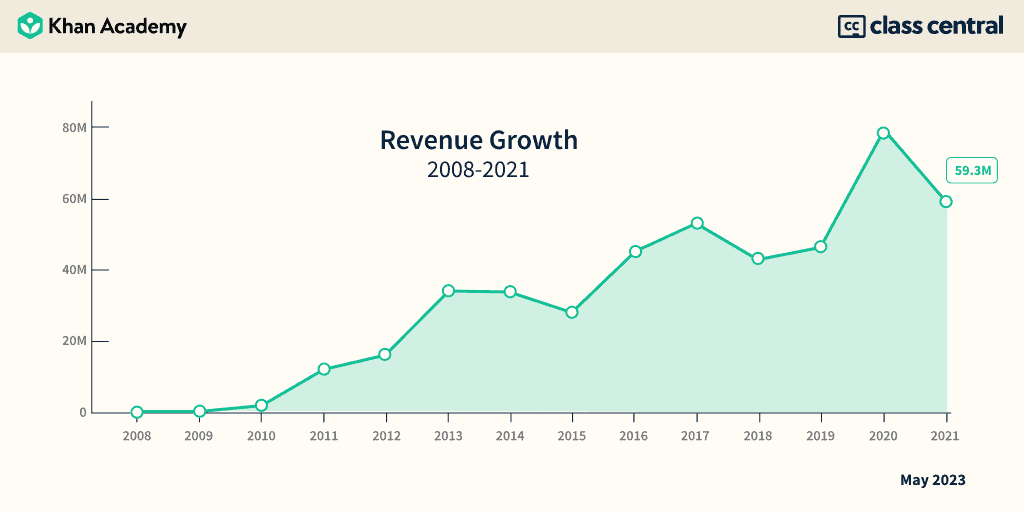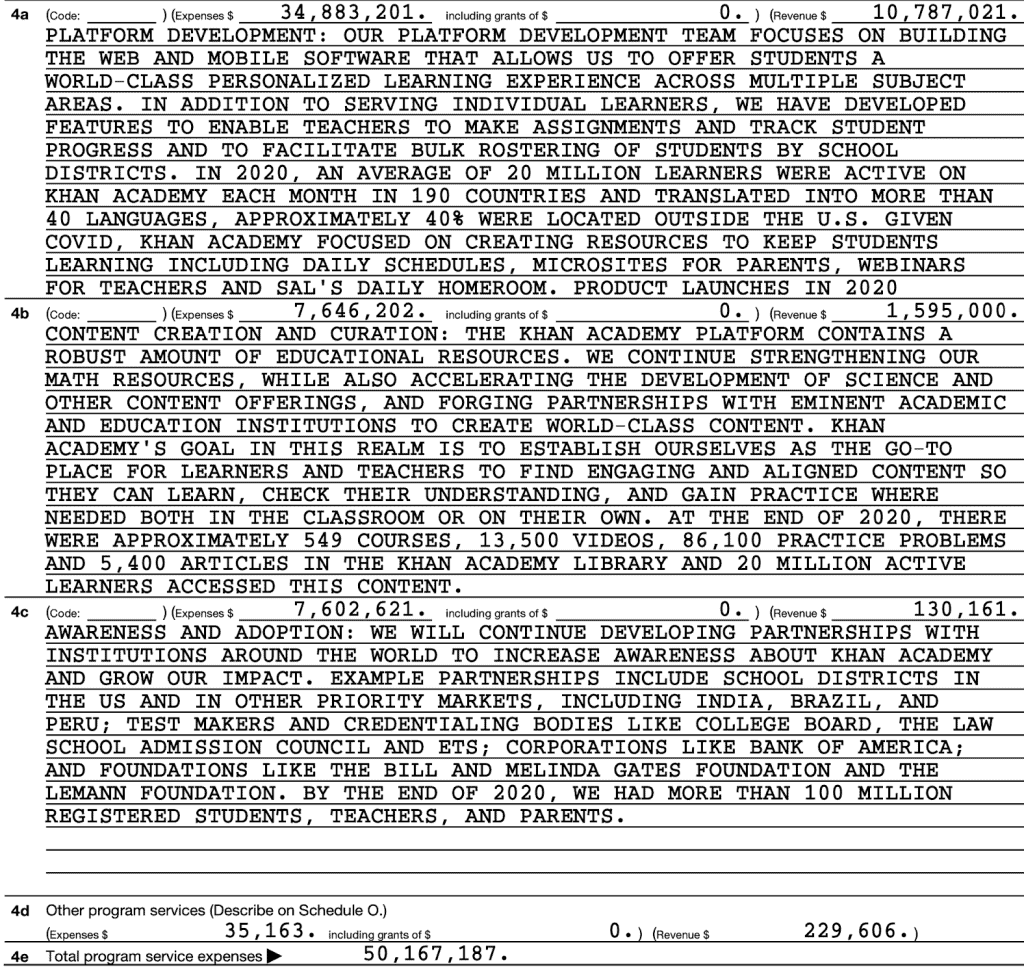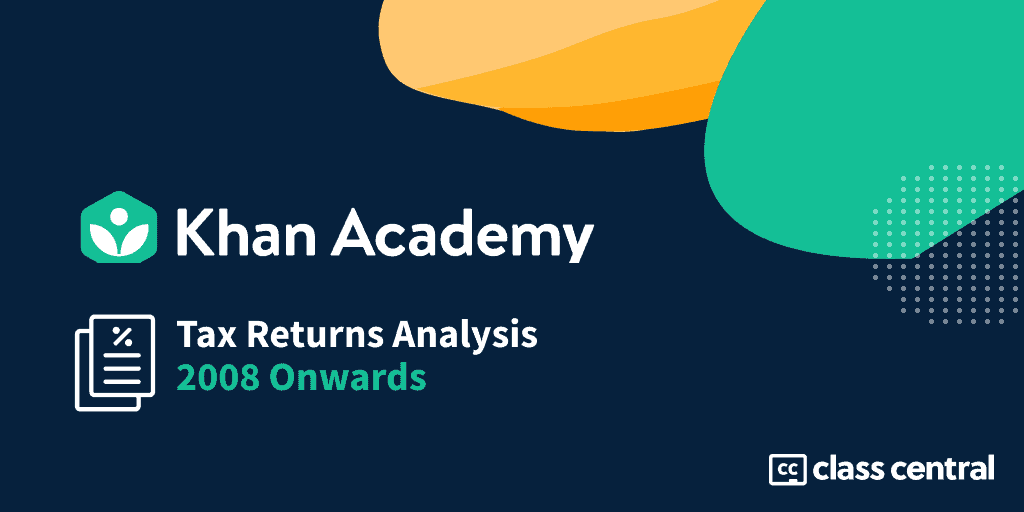The Business of Online Education: Khan Academy Tax Returns Analysis (2008–2021)
Khan Academy has received $365M in donations and saw an important boost during the pandemic.
- $365 million in donations and $80 million in “program services revenue” since 2008
- $3.4 million in grants awarded to Khan Lab School
- $115 million in net assets at the end of 2021
Sal Khan, founder of Khan Academy, is probably the most well-known name in online education (and maybe education in general). In various interviews, I’ve heard the founders of Coursera, edX, and Udacity credit Sal Khan as the inspiration behind their companies.
And as I was looking through Khan Academy’s Tax Returns from 2008–2021, the data seemed to agree. 2011 was a breakthrough year for Khan Academy, with contributions rising from $1.8 million to $11.8 million and the number of employees growing from 3 to 30. In March 2011, Salman Khan published his Ted talk.
Later that year, three Stanford online courses went live, leading to the birth of the modern MOOC (or Massive Open Online Courses) movement. The following year, NYT called 2012 the Year of the MOOC. The timeline fits perfectly.
2020 was the “Second Year of the MOOC”. The same can be said about Khan Academy. We can clearly see the impact of the pandemic on Khan Academy’s finances. It received as much money in 2020 as it did in the previous two years combined. Like other companies, Khan Academy also experienced a post-pandemic slowdown in 2021, which is reflected in its revenues.

One of the goals of the Class Central Report is to decipher the online education business. Previously, I analyzed the public filings of Coursera, Udemy, and Thinkific, wrote about Coursera’s monetization journey as they went from zero to IPO, and wrote a 4,500-word analysis of 2U’s acquisition by edX.
Since Khan Academy is a non-profit, its tax returns are publicly available. This is my first attempt at analyzing Khan Academy. If there’s interest, I can revisit it in the future, go deeper, and collect data from other sources to paint a fuller picture.
I’ll also update the article with Khan Academy Revenues 2022, when the latest tax returns are available.
Khan Academy Revenues 2021 vs 2020
| 2021 | 2020 | |
| Revenues | $59.3M | $79.3M |
| Contributions and Grants | $48.7M | $65.7M |
| Program Service Revenue | $9.4M | $12.6M |
| Expenses | $53.9M | $56.8M |
| Net | ($5.4M) | $22.6M |
| Employees | 229 | 197 |
| Volunteers | 1,400 | 1,400 |
| Registrations | 140M | 118M (27.3M new) |
In the school year 2021-2022, Khan Academy achieved a total of 140 million registrations, adding 14.8 million learners. These learners accounted for 7 billion minutes of learning
In 2020, Khan Academy had 27.3 million new registrations, a growth of 41% over the prior year. It received on average 17.7 million learners monthly, who accounted for 12.8 billion minutes of learning.
Before 2020, Khan Academy was starting to see a decline in Contributions and Grants and an increase in Program Service Revenue. But in 2020 (as you’ll see later), it received as much in contributions and grants as it did in the 2019 and 2018 and combined. It also saw a drop in Program Service Revenue.
According to their 2021-2022 annual report, here’s the breakdown of their revenue:
| 2021 | 2020 | |
| Foundation and Individual Gifts | $24.6M | $52.6M |
| Corporate Gifts | $16.3M | $6.8M |
| Community Giving | $8.0M | $8.8M |
| Earned Income | $9.2 | $12.4M |
| Other Income | $1.1M | $1.6M |
In 2021, there was a significant decline of more than 50% in Foundations and Individual Gifts. However, this was partially offset by a $10 million increase in Corporate Gifts.
In the 2020 tax returns, I saw a mention of two separate donations of Google Shares worth $10.8M combined (the Google stock price almost doubled since the stock was donated).
How Does Khan Academy Make Money?
Khan Academy has two major sources of revenue: Contributions and Grants and Program Service Revenue. In 2021, it received $48.7 million in Contributions and Grants, while it made $9.4M in Program Service Revenue.
Program Service Revenue is a bit of a mystery, which I will try to dig into later. Here’s how these two revenue sources have grown over the years::
| Fiscal Year | Contributions and Grants | Program service revenue | Total Revenue |
| 2021 | 48.7M | 9.4M | 59.3M |
| 2020 | 65.7M | 12.6M | 79.3M |
| 2019 | 27.6M | 17.2M | 46.2M |
| 2018 | 31.4M | 10.3M | 42.7M |
| 2017 | 42.8M | 9.4M | 52.8M |
| 2016 | 36.3M | 8.3M | 44.8M |
| 2015 | 24.4M | 3.5M | 27.9M |
| 2014 | 29.7M | 4.0M | 33.7M |
| 2013 | 29.6M | 4.4M | 34.0M |
| 2012 | 15.2M | 558K | 15.8M |
| 2011 | 11.8M | 0 | 11.8M |
| 2010 | 1.8M | 2.7K | 1.8M |
| 2009 | 2.9K | 0 | 8.9K |
| 2008 | 0 | 0 | 0 |
Contributions and Grants: $365M since 2008
In total, by the end of 2021, Khan Academy has received $365M, with one third of this amount received the last two years
Here’s the distribution of Khan Academy’s donors in 2021, according to their 2021 Annual Report:
| Tiers | 2021 | 2020 |
| $1,000,000 and above | 14 | 20 |
| $500,000 – $999,999 | 5 | 7 |
| $250,000 – $499,999 | 2 | 4 |
| $100,000 – $249,000 | 18 | 11 |
| $50,000 – $99,999 | 16 | 12 |
| $25,000 – $49,999 | 22 | 18 |
| $1,000 – $24,999 | ~775 | ~1050 |
Program Service Revenue: $80M since 2008
We know how much money Khan Academy makes, but it’s unclear to me how it made $9.4M in 2021 and $12.6M in 2020. The tax returns aren’t very granular in this aspect, only breaking revenue down into vague categories.
Khan Academy categorizes program services revenue in two major categories:
- Platform Development
- Content Creation and Curation

Deeper in the tax returns, fees are broken down into four categories: Development Fees, Maintenance Fees, Content Licensing Fees, and Speaking Fees.
| Year | Development Fees | Maintenance Fees | Content Licensing Fees | Speaking Fees |
| 2021 | 4.3M | 3.6M | 1.3M | 124,040 |
| 2020 | 6.3M | 4.5M | 1.6M | 229,606 |
| 2019 | 9.0M | 4.1M | 3.7M | 380,125 |
| 2018 | 3.0M | 3.1M | 4.0M | 214,500 |
| 2017 | 2.0M | 3.0M | 4.0M | 383,987 |
| 2016 | 2.0M | 2.2M | 3.4M | 749,750 |
| 2015 | 120,548 | 2.8M | 669,600 | |
| 2014 | 3.6M | 214,831 | ||
| 2013 | 3.9M | 227,929 | ||
| 2012 | 106K |
If anybody has insights into who is paying Khan Academy and for what, please let me know in the comments or reach out to me at [email protected].
Khan Academy Expenses
In 2018 and 2019, Khan Academy was losing money on an annual basis due to an increase in expenses and decrease in Contributions and Grants. But it did have tens of millions in assets and could have sustained this situation for a few years.
But in 2020, it got a big boost in Contributions and Grants, making it Khan Academy’s most profitable year since 2013. In 2021, it was back to losing money.
| Fiscal Year | Total expenses | Net |
| 2021 | 53.9M | -5.4M |
| 2020 | 56.8M | 22.6M |
| 2019 | 54.3M | -8.1M |
| 2018 | 48.9M | -6.1M |
| 2017 | 37.5M | 15.3M |
| 2016 | 29.4M | 15.5M |
| 2015 | 24.1M | 3.8M |
| 2014 | 19.1M | 14.6M |
| 2013 | 11.3M | 22.7M |
| 2012 | 7.3M | 8.5M |
| 2011 | 3.0M | 8.9M |
| 2010 | 237K | 1.5M |
| 2009 | 5.5K | 3.4K |
| 2008 | 0 |
Khan Academy’s biggest expense is its employees, accounting for more than 70% of its total expenses in 2020. Since 2008, it has spent ~$250 million on compensation and employee benefits.
| Fiscal Year | Salaries, other compensation, employee benefits | Part VII, Section A salaries | Total Employees |
| 2021 | 39.4M | 5.0M | 229 |
| 2020 | 41.7M | 4.7M | 197 |
| 2019 | 38.6M | 4.5M | 251 |
| 2018 | 35.0M | 3.5M | 234 |
| 2017 | 27.3M | 3.3M | 219 |
| 2016 | 19.7M | 3.0M | 180 |
| 2015 | 16.0M | 3.9M | 147 |
| 2014 | 12.4M | 3.0M | 114 |
| 2013 | 8.1M | 2.3M | 90 |
| 2012 | 5.9M | 2.0M | 53 |
| 2011 | 2.2M | 1.3M | 30 |
| 2010 | 139K | 121K | 3 |
| 2009 | 1 | ||
| 2008 | 1 |
In 2020, it did see a big drop in the number of employees from 251 to 197, but the related expenses still went up. I think this might be due to the switch to remote work and employees becoming “contractors”.
“Part VII, Section A” salaries accounted for 13% of the total Salary expenses. The highest paid employee in 2021 was Sal Khan with a salary of $856K.

Khan Lab School is an actual school founded by Sal Khan in 2014, which now has two campuses in Silicon Valley (Mountain View and Palo Alto). It costs $29k – $33k per student per year and has a total of 230 students.
It is a separate non-profit organization from Khan Academy, but over the years it has received $3.4 million in grants from Khan Academy.
| 2020 | NA |
| 2019 | 140K |
| 2018 | 215K |
| 2017 | 384K |
| 2016 | 1.2M |
| 2015 | 914K |
| 2014 | 530K |
I didn’t analyze Khan Lab School tax returns, but in 2021 it had a revenue of $7.7 million with a net income of $853k.








Quim (Edpuzzle)
Dhawal! As always, super interesting analysis! Congrats my friend!
Wayne Whiteman
Thumbs up Dhawal. Wayne Whiteman